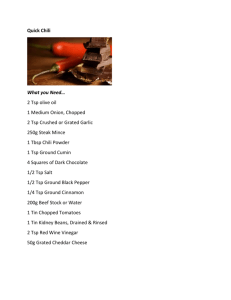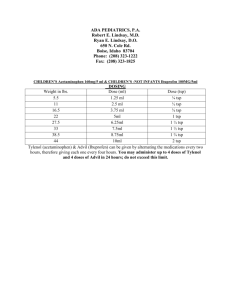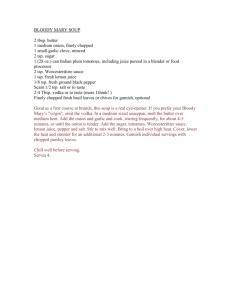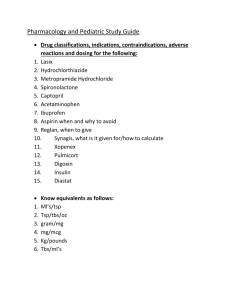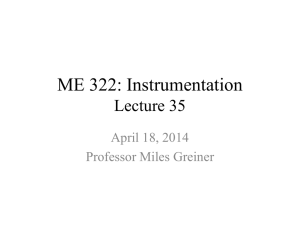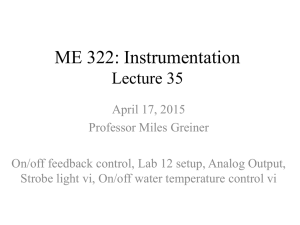Lecture Slides
advertisement
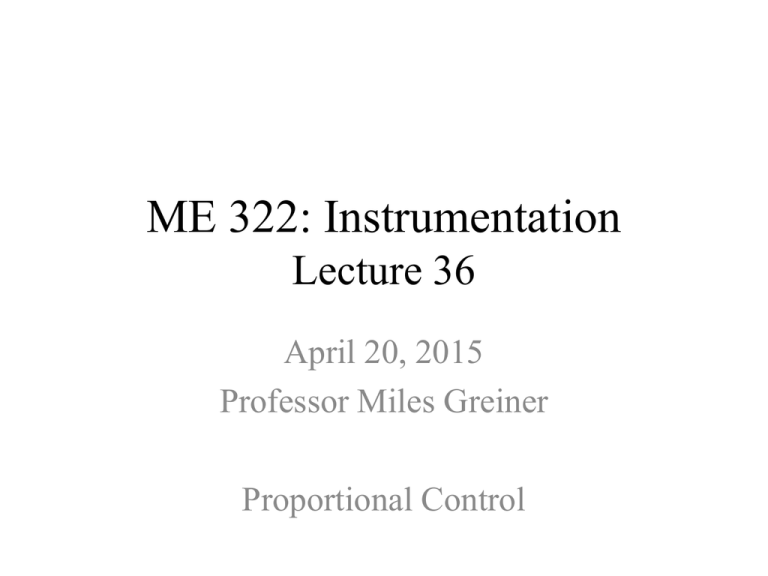
ME 322: Instrumentation Lecture 36 April 20, 2015 Professor Miles Greiner Proportional Control Announcements/Reminders • HW 12 Due Friday • This week: Lab 11 Unsteady Karmon Vortex Speed • One-hour periods with your partner • Schedule on WebCampus – Please be on time and come prepared! • Lab Practicum Final – Guidelines, Schedule • http://wolfweb.unr.edu/homepage/greiner/teaching/MECH322Instrumentation/Tests/Index.htm – Schedule • On WebCampus • Please let me know if there are conflicts with other finals – Practice Periods • May 2-3, 2014 Lab 12 Setup • Measure beaker water temperature using a thermocouple/conditioner/myDAQ/VI • Use myDAQ analog output (AO) to operate a digital relay that turns heater on/off to control the water temperature Full on/off Control • LabVIEW VI “logic” – Measure thermocouple temperature for 1 sec • Average, T, display – Compare to TSP (compare and select icons) – Turn 200 W heater on/off if T is below/above TSP – Waveform Chart • T and TSP versus time • e = T-TSP versus time – Repeat • Constructed last lecture – http://wolfweb.unr.edu/homepage/greiner/teaching/MECH322Instrumentation /Labs/Lab%2012%20Thermal%20Control/Lab%20Index.htm Full On/Off Temperature Control Front Panel On/Off Control Temperature Response • Full On/off control – – – – Reaches TSP after ~3 minutes Gives oscillatory response Average temperature TAvg > TSP Maximum error is roughly 2.5°C • Want heater power to be high to reach TSP quickly • Would oscillations decrease if power decreased near T ~ TSP? How to reduce heater power using a relay? FTO = 0.1 FTO = 0.5 FTO = 0.9 • Reduce the Fraction of Time the heater is On (FTO) – Maximum heater power QMax = V2/R • Reduce FTO to decrease heater power – Heater Q = (FTO)(QMax) • How to implement this in LabVIEW? Strobe Light VI • Stacked sequence loop • Milliseconds to Wait • Vary cycle time and FTO Proportional Control • Reduce heater power (FTO) when T is within a small increment DT of TSP – Define 𝑓 𝑇 = 𝑇𝑆𝑃 −𝑇 (= 𝐷𝑇 1 𝑎𝑡 𝑇 = 𝑇𝑆𝑃 − 𝐷𝑇; = 0 𝑎𝑡 𝑇 = 𝑇𝑆𝑃 ) • Three temperature zones: – For T < 𝑇𝑆𝑃 − 𝐷𝑇 , – For 𝑇𝑆𝑃 − 𝐷𝑇 < 𝑇 < 𝑇𝑆𝑃 , – For 𝑇 > 𝑇𝑆𝑃 , f> 1 FTO = 1 1 > f >0 f <0 𝐹𝑇𝑂 = 𝑓 FTO = 0 • For DT = 0, Proportional is same as full power On/Off • What is Q when T = 𝑇𝑆𝑃 ? – Why isn’t that good? How to construct a Proportional-Control VI Current Temperature • Calculate FTO – Indicate FTP using a bar, dial and/or numeric indicator • Use stacked sequence loop to turn heater on and off • Write to a Measurement File VI – Segment Headings (No Headers) – X value (time) Column (one column only) • Starting Point Proportional Control Proportional-Control Temp versus Time 90 On/Off 80 T Temperature, T [C] 70 TSP Proportional 60 TSP - DT 50 Proportional 40 30 20 0 10 20 30 40 50 60 70 80 90 Time, t [minutes] • TSP = 65°C and TSP = 85°C • As DT is increases (control becomes more proportional) – Oscillatory amplitude decreases • Temperature eventually becomes steady – The “steady-state” average temperature 𝑇𝐴𝑉𝐺 decreases • Error magnitude 𝑒 = 𝑇𝐴𝑉𝐺 − 𝑇𝑆𝑃 increases with DT and 𝑇𝑆𝑃 Average Temperature Error and Unsteadiness versus DT and TSP 2.0 1.4 1.5 1.2 1.0 1.0 0.0 TRMS [C] TA - TSP [°C] 0.5 TSP = 65°C -0.5 0.8 TSP = 85°C 0.6 -1.0 -1.5 0.4 TSP = 85°C TSP = 65°C -2.0 0.2 -2.5 0 1 2 3 4 5 DT [°C] 6 7 8 9 10 0.0 0 1 2 3 4 5 6 7 8 9 10 DT [C] • The average temperature error 𝑒 = 𝑇𝐴𝑉𝐺 − 𝑇𝑆𝑃 – Is positive for DT = 0, but decreases and becomes negative as DT increases. – Decreases as TSP increases • TRMS (same as standard deviation) is and indication of thermocouple temperature unsteadiness – Unsteadiness decreases as DT increases, and as TSP decreases. Proportional-Control Questions • Why is the steady temperature below the set-point (desired) value? • Why do temperature oscillations disappear as DT gets larger? • Is there another control technique that eliminates the steady state error? Steady State Temperature Error • 𝑄 − 𝑊 = 𝑄𝐼𝑛 − 𝑄𝑂𝑢𝑡 = 𝑇𝑆𝑃 −𝑇 𝐷𝑇 • 𝑄𝑀𝑎𝑥 𝑑𝑈 𝑑𝑡 = 𝑑𝑇 𝜌𝑐𝑉 𝑑𝑡 − ℎ𝐴 𝑇 − 𝑇𝐸𝑛𝑣 = 𝜌𝑐𝑉 𝑑𝑇 𝑑𝑡 • Let 𝑇𝑆𝑆 be the temperature under steady state conditions – • 𝑑𝑇𝑆𝑆 𝑑𝑡 =0 𝑇𝑆𝑃 −𝑇𝑆𝑆 𝑄𝑀𝑎𝑥 𝐷𝑇 = ℎ𝐴 𝑇𝑆𝑆 − 𝑇𝐸𝑛𝑣 – 𝑄𝑀𝑎𝑥 𝑇𝑆𝑃 − 𝑇𝑆𝑆 = ℎ𝐴 𝐷𝑇 𝑇𝑆𝑆 − 𝑇𝐸𝑛𝑣 – 𝑄𝑀𝑎𝑥 𝑇𝑆𝑃 + ℎ𝐴 𝐷𝑇 𝑇𝐸𝑛𝑣 = 𝑇𝑆𝑆 ℎ𝐴 𝐷𝑇 + 𝑄𝑀𝑎𝑥 • 𝑇𝑆𝑆 = 𝑄𝑀𝑎𝑥 𝑇𝑆𝑃 +ℎ𝐴𝑇𝐸𝑁𝑉 𝐷𝑇 𝑄𝑀𝑎𝑥 𝐷𝑇+ℎ𝐴 • 𝑒𝑆𝑆 = 𝑇𝑆𝑆 − 𝑇𝑆𝑃 = − 𝑇𝑆𝑃 −𝑇𝐸𝑁𝑉 𝑄 𝑀𝑎𝑥 1+ℎ𝐴 𝐷𝑇 – Magnitude increases with 𝑇𝑆𝑃 − 𝑇𝐸𝑁𝑉 and ℎ𝐴 𝐷𝑇 𝑄𝑀𝑎𝑥

